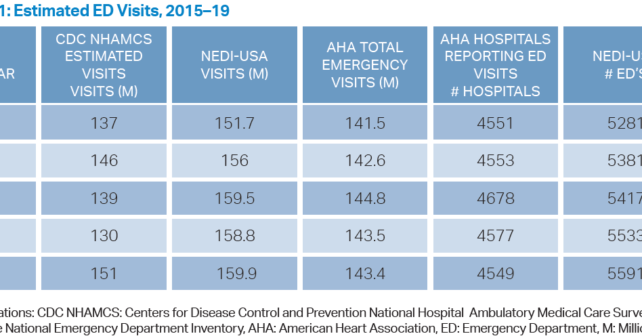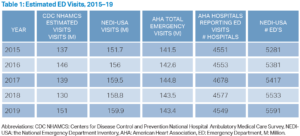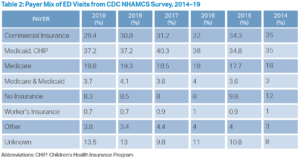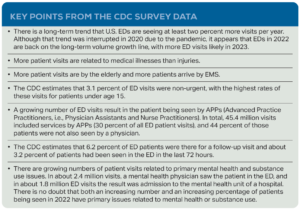
The Centers for Disease Control and Prevention (CDC) statistical survey of emergency department (ED) visits for 2019 was released in April 2022.1 The analysis of this survey performed by the Emergency Department Benchmarking Alliance (EDBA) is meshed with ED performance data to provide insights that advance the industry and prepare ED leaders for patient needs in upcoming years.
Explore This Issue
ACEP Now: Vol 41 – No 11 – November 2022The CDC data is the oldest consistent data source for the U.S., but estimates of total ED visits remain different between the national data sources. For 2019, the CDC found 151 million ED visits, while the National Emergency Department Inventory found 159.9 million ED visits, and the American Heart Association estimated that there were 143.4 million visits. Some of the difference in these totals are explained by the different numbers of EDs that are counted in the surveys.2 The National Emergency Department Inventory survey is the most comprehensive. ED visit estimates for the last five years are compiled in Table 1.
ED visits have increased from 36.9 visits per 100 population in 1995 to 46.6 per 100 population in 2019. The highest utilization rate of emergency services per population is visits by homeless persons, then visits by nursing home residents, then visits by infants under age one.
The ED population is aging, in line with the demographics of the country. Persons aged 75 and over had 66 visits per 100 population in 2019. In line with aging U.S. demographics, EDs need to prepare for larger numbers of senior patients. Older patients require more time and more diagnostics and treatment. Since they are admitted to the hospital more often, they spend more time in the ED as boarders. Those planning new or renovating old EDs should account for these shifting demographics, specifically planning bed capacity and staffing for longer lengths of stay.
The CDC survey confirms the higher acuity trend that has been reported in EDBA studies. There are more high-acuity visits, senior patients, ambulance arrivals, diagnostic tests, and patients with mental health issues. Injury visits continue to shrink, and now represent 27 percent of visits. The biggest increase in injuries occurs in the elderly.
There is an ongoing increase in the use of diagnostic tools in the ED, especially ECGs, CT scans, MRIs, and ultrasounds.
Consistent with the adage that the ED is the “front door to the hospital,” there is continuing growth in the percentage of overall hospital admissions presenting through the ED. The EDBA data survey finds that 69 percent of hospital inpatients are processed through the ED.
Payer mix in 2019 trended in line with numbers from prior years. This is the fifth year that Medicaid and CHIP accounted for the largest expected source of payment—40.9 percent of ED visits. Next was private insurance (at 29.4 percent of ED visits), Medicare (19.8 percent), and no insurance (8.3 percent). Table 2 reflects the trend in the payer mix over the last five years of CDC data collection. For most EDs, Medicare and Medicaid will make up at least 50 percent of the payer mix. The most frequent payer type for patients admitted to the hospital through the ED was Medicare (44 percent) followed by private insurance (31 percent), Medicaid/CHIP or other state-based program (26 percent), and no insurance (five percent).
 Dr. Augustine is national director of prehospital strategy for US Acute Care Solutions in Canton, Ohio, clinical professor of emergency medicine at Wright State University in Dayton, Ohio, and vice president of the Emergency Department Benchmarking Alliance.
Dr. Augustine is national director of prehospital strategy for US Acute Care Solutions in Canton, Ohio, clinical professor of emergency medicine at Wright State University in Dayton, Ohio, and vice president of the Emergency Department Benchmarking Alliance.
References
- Cairns C, Kang K, Santo L. National hospital ambulatory medical care survey: 2019 emergency department summary tables. Centers for Disease Control and Prevention website. www.cdc.gov/nchs/data/nhamcs/web_tables/2019-nhamcs-ed-web-tables-508.pdf. Updated July 29, 2022. Accessed October 9, 2022.
- Augustine, James J. ED usage trends before COVID-19. ACEP Now. 2020;39(5):21.
Pages: 1 2 | Multi-Page








No Responses to “Emergency Department Patient Challenges to Come”